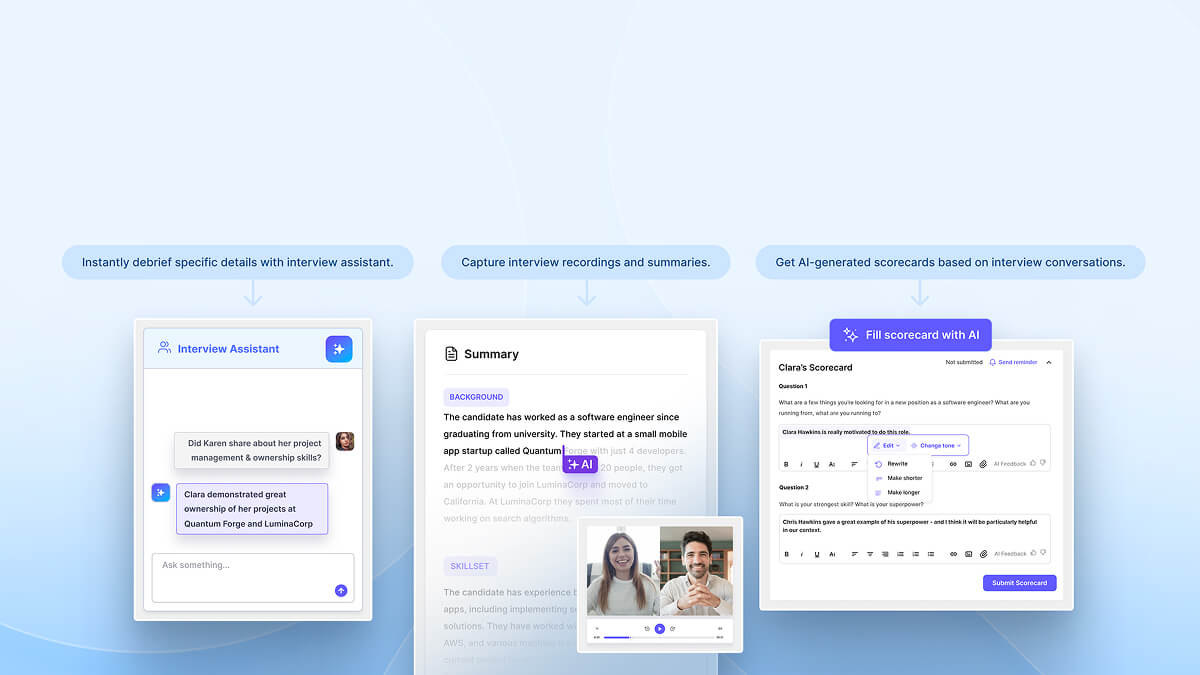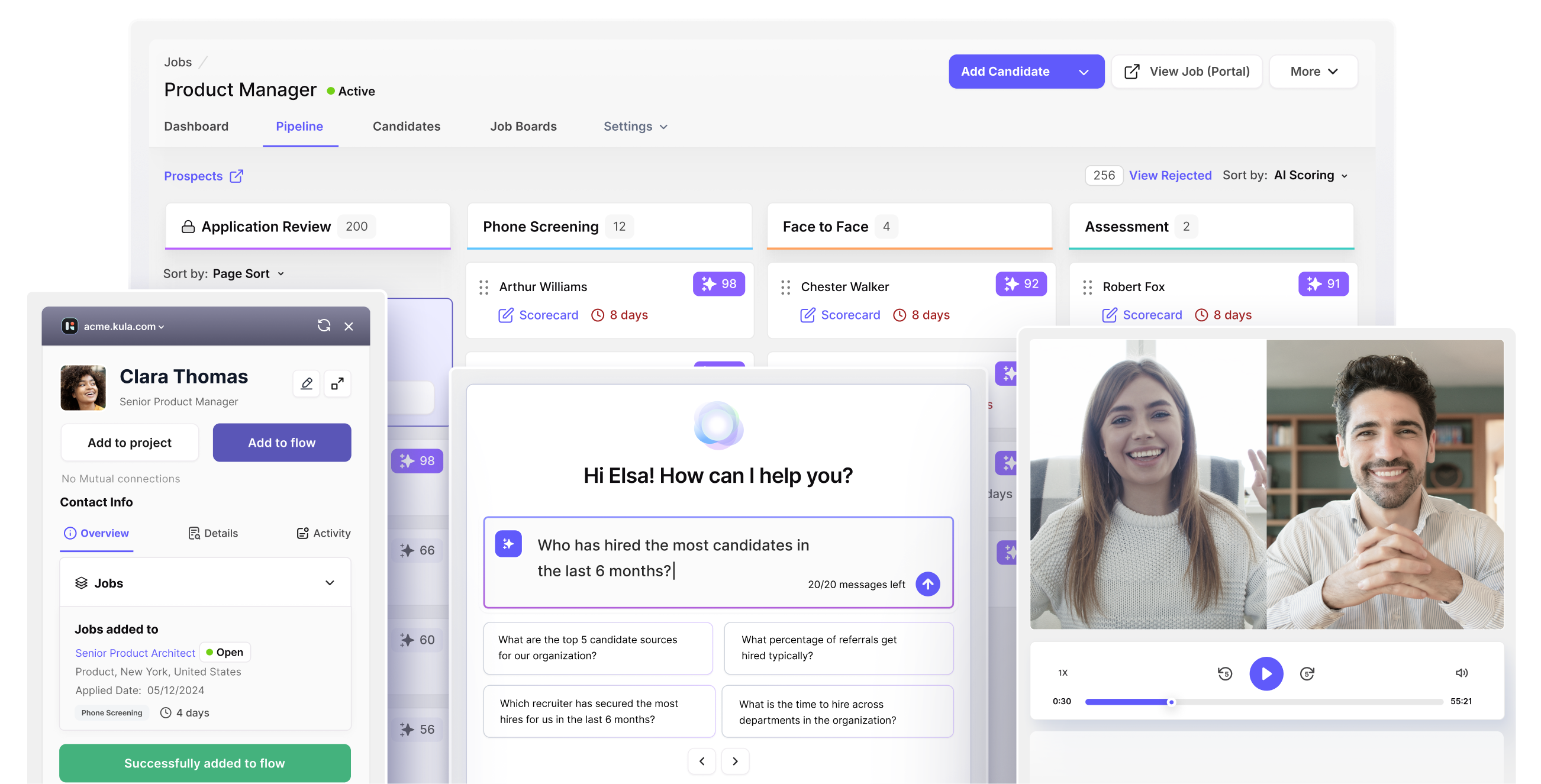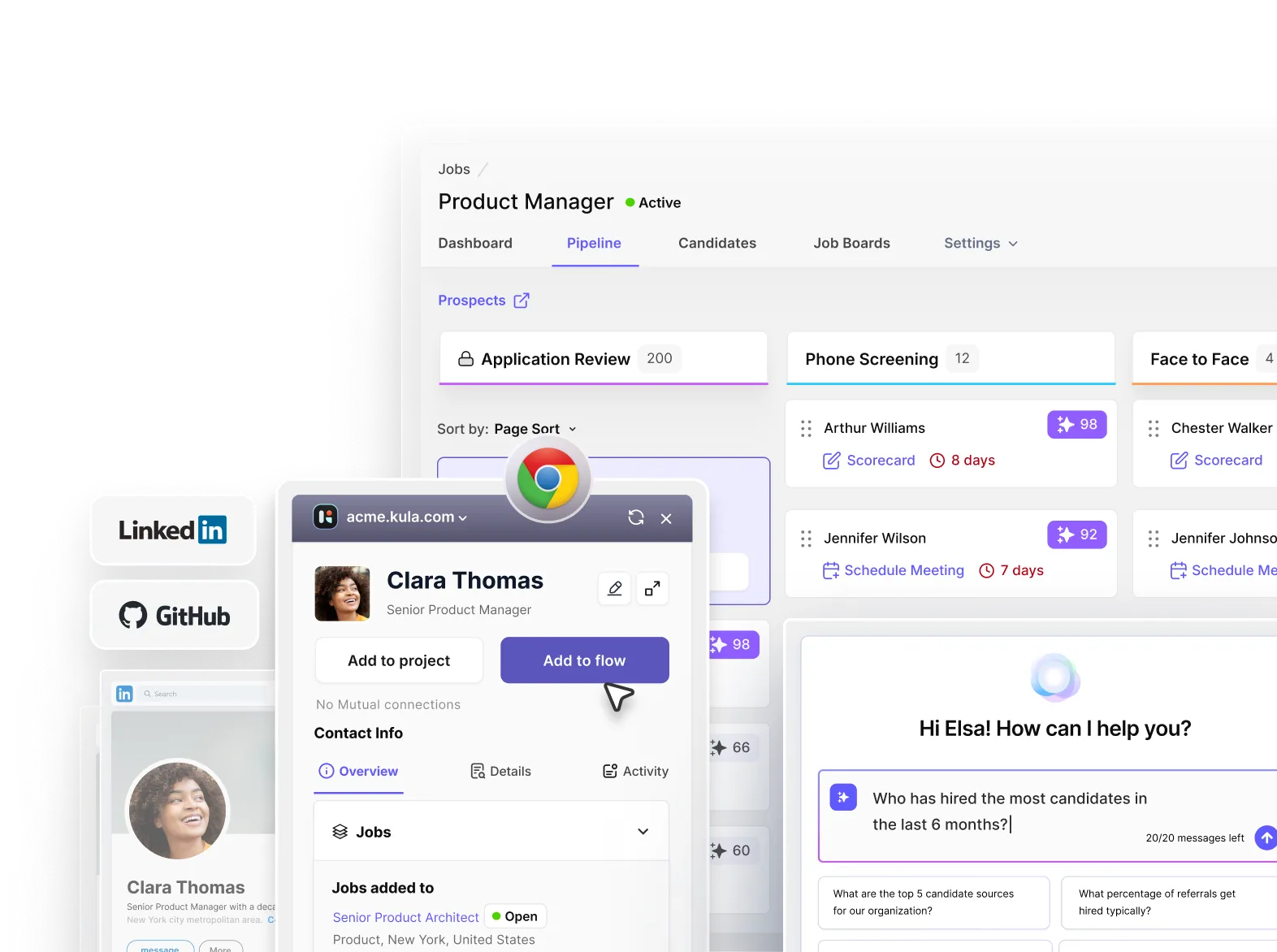Book a 30-minute demo and learn how Kula can help you hire faster and smarter with AI and automation
So, you've got a killer idea, secured some funding, and now you're ready to build your dream team.
But sadly, startup hiring can feel like trying to find a needle in a haystack... while blindfolded... and the haystack is on fire.
Don't worry, we've got your back.
In this ultimate guide, we're going to dive deep into the world of startup hiring.
Whether you're looking to bring on your first employee or scale up to a team of 50, we've got the strategies, tips, and tricks you need to build a stellar team that'll take your startup to the next level.
👉TL;DR
- Hiring for startups is different as you lack brand recognition, resources are tight, and every hire has a big impact.
- Start with the 3 Ws: define what roles you need, when you need them, and who you’re looking for.
- Building a strong employer brand is important for startups to form connections by showcasing mission, culture, and team stories to stand out.
- Tap into multiple networks, niche job boards, and social platforms for sourcing, and if you can’t match salaries, offer equity, flexibility, remote work, or personalized perks.
The startup hiring challenge: Why it's not business as usual
First things first, let's address the elephant in the room: Hiring for a startup is a whole different ballgame compared to recruiting for established companies.
Here's why:
- You're an unknown entity (for now)
- Resources are tight
- Every hire can make or break your team
- You need generalists who can wear multiple hats
- The stakes are higher than ever
When you're just starting out, nobody knows who you are.
You don't have the brand recognition of Google or the cool factor of the latest VC-backed unicorn.
This means you have to work extra hard to sell your vision and convince top talent to take a chance on you.
As Dharmesh Shah, co-founder of HubSpot, puts it:
"I meet too many founders who've read 27 blog posts on landing page optimization but make it up as they go along in interviews. Startup literature urgently needs more guides to headhunting and fewer how-tos on the email etiquette of VC introductions."
Too often, founders spend all their time perfecting their product and pitch deck, but treat hiring as an afterthought.
But here's the truth: your team is your most valuable asset, and the process of hiring is the most important force.
While it’s an obvious indication to start hiring when founders can’t continue to be the HR, the CTO, the finance person, and (sometimes) the receptionist themselves, things can get out of hand quickly if you end up recruiting without a plan.
Ask the 3 Ws to yourself before you begin to hire in 2025
1. What are you hiring for?
Figure out the roles that you really need at a particular point in time and in the future. Ask yourself: Is this position essential right now, or is it something that can wait?
Write it down to avoid confusion later, and make sure it aligns with your company’s growth plans.
2. When would you need someone to fill the said role(s)?
You can hire ahead of time or when the need arises. Align your recruiting roadmap with long-term as well as short-term goals.
Be clear with the timelines, so you don’t have to run around at the eleventh hour.
3. Who you’re looking for?
Be very clear about what you’re looking for in a candidate.
This could be their personality, their personal and professional goals, interests, and their aspirations to work with startups.
Write down what an ideal team player would look like.
Once you’re pretty clear with your hiring requirements, do remember that candidates may or may not know about your brand. So, start putting the pieces of your brand story together such as:
- About your brand
- Your mission statement
- Your plans for the next few quarters/years
- Prepare your recruiting arsenal aka the resources
- Build a Careers page that strikes a chord
Create a careers section on your website by showcasing what employees mean to you, plug in real stories from existing team members and investors, and tell them what it is like to be a part of YOUR startup and how they can really make a difference.
Some of the examples: CRED, Gong, Insider, Drift, AirBnB’s Internship Page
Beyond the 3Ws: How to Work With, Align, and Onboard Your Startup Hires
1. Define and assess the values they need to have
First things first, define your culture. we know, it sounds obvious, but you'd be surprised how many founders skip this step.
Take a moment to think about what your startup really stands for.
- Are you all about innovation and risk-taking?
- Or do you prioritize careful planning and execution?
There's no right or wrong answer here - it's about being true to your startup's identity.
Once you've got a handle on your culture, it's time to get creative with your interview questions.
Forget the old "Where do you see yourself in five years?" snoozer. Try these on for size:
- "Tell me about a time when you disagreed with your boss. How did you handle it?"
- "If you could design your perfect workday, what would it look like?"
- "What's the biggest mistake you've made in your career, and what did you learn from it?"
These questions can give you a peek into a candidate's values, work style, and how they handle challenges.
💡Pro tip: Get your team involved. Have candidates meet with several team members.
Not only does this give you multiple perspectives on fit, but it also allows the candidate to get a better sense of your culture. Win-win!
2. Building your employer brand
Before you even think about posting that job ad, you need to work on your employer brand.
Why? Because in the competitive world of startup hiring, you need to give top talent a reason to choose you over the hundreds of other exciting startups out there.
Here's how to build a strong employer brand:
- Define your mission and values: Make it clear why your company exists and what you stand for. Ensure every decision aligns with these values.
- Showcase your team and culture: Use social media to give potential candidates a real sense of what it's like to work at your startup.
- Create engaging content: Share your startup journey, including the ups and downs. This attracts people who are excited by the startup rollercoaster.
- Offer transparency: Be open about your challenges as well as your successes. This attracts problem-solvers who want to make a real impact.
- Leverage your founders' personal brands: Encourage your founders to be active on social media, speak at events, or write blog posts. Their passion can be a powerful draw for potential employees.
💡Pro tip: Take a page out of Buffer's book and embrace radical transparency. Their "Open" blog and salary calculator have created massive buzz and attracted top talent who value honesty and openness.
3. Craft killer job descriptions
Now that you've got your employer brand shining bright, it's time to craft job descriptions that'll make top talent sit up and take notice.
Here's the secret sauce: Use an attention-grabbing title: But avoid bro culture terms like "ninja" or "rockstar".
- Start with a compelling company overview: Briefly explain what your company does and why it matters.
- Clearly outline responsibilities and must-have skills: Be specific about what the role entails and what you're looking for.
- Highlight growth opportunities and impact potential: Show how this role can make a difference and grow within your company.
- Showcase your unique culture and values: Give a taste of what it's like to work at your startup.
- Be transparent about compensation and benefits: If you can't compete on salary, highlight other benefits like equity or flexible work arrangements.
Here's a quick before-and-after to show you the difference:

PS: You can craft a perfect job description in seconds with Kula AI! Try here.

4. Pick the right channels for candidate sourcing
For this:
- Tap into your network: Your team's connections are golden. Make it a game: offer a prize for the most creative referral. Don't forget investors, advisors, or even that chatty barista who knows everyone. As Reid Hoffman says, "Your network is your net worth."
- Hit the pavement (or the Zoom room): Face-to-face still matters, whether it's in-person or virtual. Conferences, meetups, hackathons - they're all talent goldmines. Bonus: speak at events to attract passive candidates who aren't actively job hunting.
- Go niche with job boards: LinkedIn is great, but niche job boards are where it's at. Hiring devs? Try Stack Overflow. Designers? Dribbble's your spot. As the saying goes, "Fish where the fish are."
- Get social (media): Social platforms aren't just for cat videos. Share your startup life on Instagram, host AMAs on Reddit, create industry challenges on TikTok. Show off your culture and give folks a reason to want in.
- Embrace the remote revolution: The world is your talent oyster. That perfect dev might be in Bali, your dream writer in Copenhagen. As Matt Mullenweg of WordPress fame puts it, "Geography is no longer our master."
Recommended read: How to source and engage top candidates with AI
5. Structure your interview process
According to a 2022 report by Glassdoor, the average hiring process takes about 23.8 days.
But here's the cool part – top candidates are often off the market in just 10 days.
The cream of the crop gets snapped up fast.
So, what's a startup to do? Speed things up without sacrificing quality.
Consider condensing your interview stages.
Maybe you can combine the initial phone screen with a short technical assessment.
Or how about a "super day" where candidates meet with multiple team members in one go?
Anu Hariharan, a partner at Y Combinator's Continuity Fund, puts it this way: "The best candidates have options. If you find someone great, move fast. Don't let bureaucracy get in the way of hiring exceptional talent."
Use the right ATS tool with AI and automation to speed up the interview process without compromising on quality.

And, don't forget to sell your vision. Help candidates see how they can be part of building something great. Share your startup's mission, your plans for growth, and how their role fits into the bigger picture.
6. Seal the deal without breaking the bank
Alright, you've found your dream candidate.
They aced the interview, vibed with the team, and you're ready to bring them on board.
But hold up - now comes the tricky part: making an offer they can't refuse, even if you can't match those cushy corporate salaries.
Once you've decided on a candidate, don't drag your feet.
Here's where you can shine:
- Equity: Give them a piece of the pie. It shows you're invested in their long-term success.
- Flexible hours: For many, the ability to pick up the kids from school or hit the gym at 2 pm is worth its weight in gold.
- Remote work options: The pandemic has shown us that work can happen anywhere. Use this to your advantage.
- Professional development: Offer a budget for courses, conferences, or mentorship programs.
- Unique perks: Maybe it's "Bring Your Dog to Work Day" every day, or a monthly team outing to escape rooms.
- Personlaized perks: Did they mention they're a coffee aficionado? Include a top-notch coffee machine as part of their welcome package.
7. Cater to diversity and inclusion
McKinsey research shows that diverse companies are 35% more likely to outperform their homogeneous counterparts.
So, how do you build a diverse and inclusive team from day one?
Start by examining your hiring process for bias. Use tools like Kula AI to scan job applications based on predefined filters that focus on skills, not names or backgrounds.

But diversity isn't just about hiring - it's about creating an inclusive environment where everyone can thrive.
Create a culture where all voices are heard and valued. This could mean implementing unconscious bias training, celebrating diverse holidays, or creating employee resource groups.
8. Decide your “courtship” or onboarding process?
A strong onboarding process can be the difference between a new hire who hits the ground running and one who's running for the hills within a month.
Start before day one.
Send a welcome package with company swag and key info. Set up their email, Slack, and other accounts in advance.
Nothing says "we're not ready for you" like spending the first day waiting for IT access.
Create a structured first week that balances orientation, team introductions, and actual work.
Assign a 'buddy' to show them the ropes (and where the good coffee is).
Set clear expectations and goals for the first 30, 60, and 90 days.
But onboarding isn't just about paperwork and training. It's about making your new hire feel welcome and connected to your mission.
Share your startup's origin story. Let them have coffee chats with different team members. Give them a small project they can own from day one.
As Twitter co-founder Biz Stone says, "Timing, perseverance, and ten years of trying will eventually make you look like an overnight success." The same goes for great employees. Invest in their onboarding, and watch them bloom.”
Use the right technology and tools to support your hiring process
Having the right tools can make all the difference.
A versatile ATS like Kula can help you manage job postings, track candidates, schedule interviews, and even analyze your hiring process. It's like having a super-organized assistant who never sleeps.
Kula AI is bias free and provides you complete arsenal from job description to AI score cards for applications and interviews. It also offers advanced Conversational AI that provides easy access to insights and helps you make final decisions faster than your competitors.
Feel free to book a demo with Kula's product specialists






















